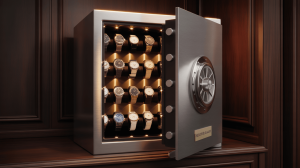Finding the right solution to secure your most treasured items can feel overwhelming. Watches, jewelry, important documents—each piece needs protection and care. A home safe designed with built-in watch winding features offers the best of both worlds. It keeps your automatics perfectly wound while locking away jewelry, cash, and documents under reinforced steel. Imagine opening a sleek cabinet and seeing your favorite timepieces ready to wear, side by side with neatly organized valuables. This one device meets the needs of precision watch care and robust security. Read on to discover every detail worth considering.
1. Understanding the Dual-Function Safe
A dual-function home safe houses valuables and winds automatic watches simultaneously. Its steel door and body resist forced entry, while interior drawers and rotating modules keep watches in motion. Instead of storing jewelry in a separate box and tensions in a standalone winder, you get one cohesive unit. This design reduces clutter, saves space, and combines security features—like multi-point locking—with precision winding tailored to each watch’s requirements.
2. Security Standards to Look For
When choosing a safe, look for UL RSC or ETL burglary certifications. These standards confirm resistance to pry bars and drills. Fire protection is equally crucial—UL 72 Class 350 ratings mean the interior remains below 350 °F for at least 30 minutes during a fire. Many models also feature recessed hinges and multi-bolt steel locking mechanisms. Biometric scanners or electronic keypads add personalized access, while bolt-down kits anchor the safe firmly to floor joists or wall studs.
3. Precision Watch Winding Mechanics
Automatic watches depend on continuous movement to maintain accuracy. Built-in winding modules simulate wrist motions with adjustable turns-per-day (TPD) settings. Basic models offer 650–1,200 TPD, while premium units reach up to 2,500 TPD. Direction controls—clockwise, counterclockwise, or bi-directional—match manufacturer recommendations and avoid wear. Motors running under 25 dB ensure near-silent operation, thanks to rubber-dampened mounts. This precision preserves lubricants and reduces servicing intervals.
| Feature | Specification | Benefit |
|---|---|---|
| TPD Range | 650–2,500 turns/day | Maintains accurate timekeeping |
| Direction Options | CW, CCW, Bi-directional | Matches each watch’s winding needs |
| Noise Level | < 25 dB | Whisper-quiet operation |
4. Interior Organization for Valuables
Inside the safe, padded drawers prevent scratches and tangles. Velvet-lined ring rolls hold bands upright, while earring posts secure pairs together. Necklace hooks suspend chains to avoid knots. Watch pillows rest snugly in winding bays until called into motion. Some safes include hidden lower drawers for documents, passports, or spare watch straps. The layout ensures every item has a dedicated spot—no more rummaging through cluttered jewelry boxes.
5. Climate and Humidity Control Essentials
Leather straps and precious metals suffer when humidity fluctuates. Look for IP54-rated door seals that block dust and moisture. Passive desiccant chambers absorb residual moisture, while active dehumidifiers maintain an ideal 40–50% relative humidity. Built-in digital hygrometers display real-time readings so you can adjust settings before damage occurs. A stable micro-environment protects both watch movements and jewelry finishes, extending their lifespan.
6. Smart Connectivity and Remote Monitoring
Modern dual-function safes include Bluetooth or Wi-Fi modules for remote monitoring. Receive instant tamper and door-open alerts on your smartphone. You can also get low-battery and humidity warnings wherever you are. A dedicated app lets you adjust winding schedules, lock or unlock the safe, and view audit logs of access events. Enterprise-grade encryption ensures these connections remain secure.
| Connectivity Feature | Functionality | Advantage |
|---|---|---|
| Bluetooth/Wi-Fi | Remote alerts and controls | Manage your safe from anywhere |
| Audit Logging | Records access events | Full accountability and traceability |
| App Integration | Adjust winding schedules | Customize settings on the go |
7. Power Supply and Backup Strategies
Built-in winding modules and electronic locks require reliable power. Most safes include an AC adapter for daily use. They also house rechargeable lithium-ion batteries as backup. Low-battery LEDs and app notifications prompt you well before power failure. A hidden mechanical override key or combination dial guarantees access if electronics malfunction. This layered approach prevents lockouts and keeps watches running during outages.
8. Installation and Anchoring Best Practices
Proper installation ensures maximum security. Begin by locating floor joists or wall studs using a stud finder. Use heavy-duty lag or sleeve anchors rated for the safe’s fully loaded weight. Level the unit before fully tightening anchors to avoid door binding. Conceal anchor heads under interior liners or cabinetry for a clean finish. For larger models, professional installation is strongly recommended to guarantee both stability and optimal performance.
| Installation Step | Action | Tip |
|---|---|---|
| Locate Studs/Joists | Use a stud finder | Mark positions clearly before drilling |
| Select Anchors | Heavy-duty lag/sleeve anchors | Match anchor strength to safe weight |
| Level Safe | Adjust base before tightening bolts | Prevent door binding for smooth access |
9. Noise and Vibration Considerations
Even high-quality motors can generate noise if not properly isolated. Look for precision winding motors running under 25 dB—about as loud as a whisper. Rubber-dampened mounts absorb vibrations, preventing them from reaching adjacent drawers or furniture. Soft-close hinges eliminate slamming, and silent locking bolts reduce clicking sounds. These features make the safe suitable for placement in bedrooms, studies, or offices without disrupting daily life.
10. Build Quality, Materials, and Aesthetics
Top-tier safes use 12–14 gauge steel for walls and doors, with weld-sealed seams for added strength. Powder-coat finishes resist scratches and corrosion. Interior hardware—hinges, bolts, and locks—should be made of corrosion-resistant alloys. Linings of velvet, suede, or leather keep items safe from surface damage. For a decorative touch, some safes feature wood veneers or leather wraps. Tempered glass panels, flush-mount keypads, and motion-activated LED lighting add a gallery-like feel to your home decor.
| Material Component | Specification | Advantage |
|---|---|---|
| Steel Gauge | 12–14 gauge | Resists forced entry and prying |
| Exterior Finish | Powder-coat / Veneer / Leather | Aesthetic appeal and durability |
| Interior Lining | Velvet / Suede | Protects against scratches and dents |
11. Budgeting and Value Assessment
Home safes with built-in winders range from $1,500 to $10,000+. Entry-level models start at $1,500 for 2–4 winding bays and basic jewelry drawers. Mid-range units ($2,500–$5,000) include climate control, LED lighting, and smart connectivity. Premium models ($5,000+) boast custom veneers, biometric scanners, and full IoT integration. Many insurance companies offer discounts for certified fire and burglary protection. Factor in long-term savings on watch servicing and jewelry repairs when weighing upfront costs.
12. Maintenance and Care Guidelines
Routine maintenance preserves both safe and contents. Dust exterior surfaces weekly with a microfiber cloth. Run empty winding cycles monthly to keep motors healthy. Test locks and electronics quarterly for reliability. Replace desiccant packs every 6–12 months, depending on local humidity. Swap backup batteries annually to avoid unexpected shutdowns. Lubricate mechanical locks per manufacturer instructions. Maintain a service log to track maintenance dates and note any issues before they escalate.
| Maintenance Task | Frequency | Tip |
|---|---|---|
| Dust Exterior | Weekly | Use a soft microfiber cloth |
| Test Locks & Winders | Quarterly | Record performance and any anomalies |
| Replace Desiccants | 6–12 months | Rotate packs to ensure effectiveness |
13. Alternatives to a Dual-Function Safe
If a hybrid solution doesn’t fit your budget or space, consider separate devices. A standalone watch winder costs $200–$500 for a 2-bay unit. A dedicated jewelry safe runs $300–$800 for moderate capacity. While cheaper, separate devices occupy more space and require multiple keys or codes. They typically lack combined security certifications, which may lower insurance discounts. A hybrid safe consolidates security and convenience in one cohesive unit.
14. When You Really Need One
A home safe with a watch winder makes sense if you own multiple automatic watches and valuable jewelry. It saves you time by eliminating manual winding tasks. Your collection remains organized, protected, and ready to wear. Frequent travelers benefit from remote alerts and battery backups. If you only have a few pieces, a single-purpose safe or winder might suffice. Evaluate your collection size, security needs, and daily routines before deciding.
| Collector Profile | Recommended Solution | Rationale |
|---|---|---|
| Watch Enthusiast | Hybrid safe with multiple winder bays | Keeps watches accurate and secure |
| Jewelry Aficionado | Hybrid safe with deep jewelry drawers | Organizes and protects multiple items |
| Casual User | Standalone winder or jewelry safe | Budget-friendly and space-saving |
15. Making the Final Decision
Choosing the right home safe with a built-in watch winder boils down to security, convenience, and budget. Score each potential model based on burglary and fire certifications, winding precision, interior layout, build quality, and price. Consider your home’s décor and available space. Think about future needs—will you add more watches or jewelry? The ideal unit protects your valuables, preserves your timepieces, and fits seamlessly into your lifestyle. With this guide, you now know exactly what to look for when investing in a hybrid home safe.
FAQ
Q1: Can I store both quartz and automatic watches in a hybrid safe?
Yes. Quartz watches can remain in static trays while automatics go in winding modules.
Q2: How often should I replace desiccant packs?
Replace desiccant packs every 6–12 months, depending on local humidity, to maintain 40–50 % RH.
Q3: Are smart alerts secure from hacking?
Premium models use AES encryption and require strong, unique passwords for remote access.
Q4: Do these safes require professional installation?
Professional installation is recommended, especially for built-in or larger units, to ensure proper anchoring and stability.
Q5: Can I expand the safe’s capacity later?
Many models offer modular trays and drawer kits, allowing you to add extra winding bays or jewelry compartments over time.







